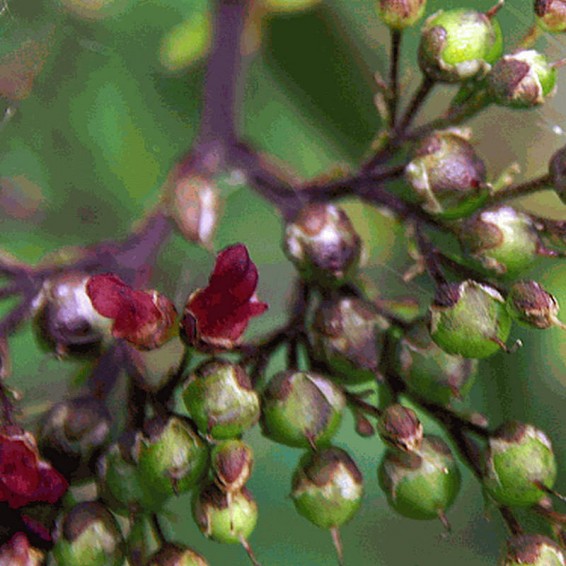Late Figwort Seeds
- HOW TO GROW
- FAST FACTS
- REVIEWS
HOW TO GROW
Sowing: Direct sow late figwort (Scrophularia marilandica) seeds in late fall, pressing into the surface of the soil since this plant needs light to germinate. For spring planting, mix the seeds with moist sand and store in the refrigerator for 30 days before planting. Keep the soil lightly moist until germination.
Growing: Water seedlings regularly until they become established. Usually flowering in its second or third year, this plant grows well in soil that does not become either too wet or too dry. Mature plants tolerate drought, but grow best with occasional watering in dry weather. This plant attracts bees and hummingbirds, and may self-seed.
Harvesting: These blossoms do not perform well as cut flowers, and are best enjoyed outdoors.
Seed Saving: After the flowers fade, the late figwort seeds will develop in a rounded seed pod that eventually begins to turn brown and dry. Gather the dried seed pods and spread them out to dry away from direct sunlight. Rub them lightly to separate the seeds from their pods. Keep the seeds in a cool, dry place.
FAST FACTS
Common Names: Carpenter's Square, Eastern Figwort
Latin Name: Scrophularia marilandica
Species Origin: US Native Wildflower
Type: Native Wildflowers
Life Cycle: Perennial
USDA Zones: 4, 5, 6, 7, 8, 9
US Regions: Plains/Texas, Midwest, Northern, Northeast, Southeast
Seeds per Ounce: 148,000
Stratification: Cold/Wet for 8 Weeks
Germination Ease: Stratify 8 Weeks
Sunlight: Full Sun, Part Sun
Height: 80 Inches
Color: Red, Green
Bloom Season: Blooms Late Summer, Blooms Early Fall, Blooms Late Fall
Uses: Attracts Pollinators, Attracts Honeybees, Attracts Butterflies, Hummingbirds
Figwort seed.
Great service, hard to find figwort seed, which just happens to be the BEST HONEY PRODUCING PLANT FOR BEES.
Seeds
Just received seeds, hope they grow good. Everwild was easy to work with, no issues.
DESCRIPTION

HOW TO GROW
Sowing: Direct sow late figwort (Scrophularia marilandica) seeds in late fall, pressing into the surface of the soil since this plant needs light to germinate. For spring planting, mix the seeds with moist sand and store in the refrigerator for 30 days before planting. Keep the soil lightly moist until germination.
Growing: Water seedlings regularly until they become established. Usually flowering in its second or third year, this plant grows well in soil that does not become either too wet or too dry. Mature plants tolerate drought, but grow best with occasional watering in dry weather. This plant attracts bees and hummingbirds, and may self-seed.
Harvesting: These blossoms do not perform well as cut flowers, and are best enjoyed outdoors.
Seed Saving: After the flowers fade, the late figwort seeds will develop in a rounded seed pod that eventually begins to turn brown and dry. Gather the dried seed pods and spread them out to dry away from direct sunlight. Rub them lightly to separate the seeds from their pods. Keep the seeds in a cool, dry place.
FAST FACTS
Common Names: Carpenter's Square, Eastern Figwort
Latin Name: Scrophularia marilandica
Species Origin: US Native Wildflower
Type: Native Wildflowers
Life Cycle: Perennial
USDA Zones: 4, 5, 6, 7, 8, 9
US Regions: Plains/Texas, Midwest, Northern, Northeast, Southeast
Seeds per Ounce: 148,000
Stratification: Cold/Wet for 8 Weeks
Germination Ease: Stratify 8 Weeks
Sunlight: Full Sun, Part Sun
Height: 80 Inches
Color: Red, Green
Bloom Season: Blooms Late Summer, Blooms Early Fall, Blooms Late Fall
Uses: Attracts Pollinators, Attracts Honeybees, Attracts Butterflies, Hummingbirds
Reviews
Review
Figwort seed.
Great service, hard to find figwort seed, which just happens to be the BEST HONEY PRODUCING PLANT FOR BEES.
Review
Seeds
Just received seeds, hope they grow good. Everwild was easy to work with, no issues.



